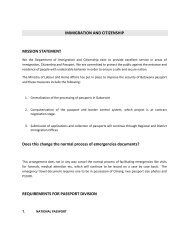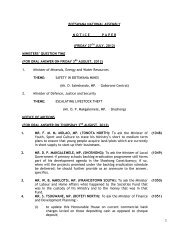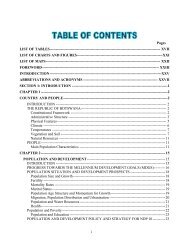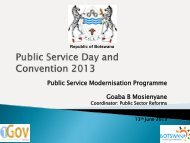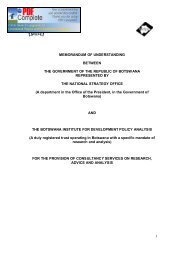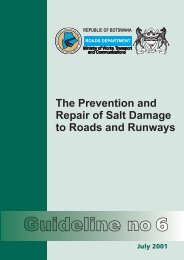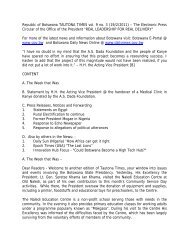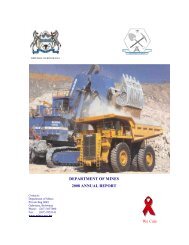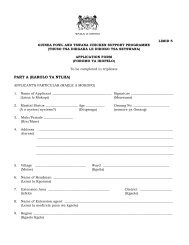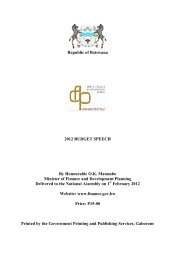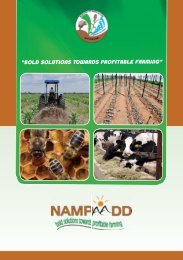National Nutrition and HIV/AIDS Guidelines for Service Providers of ...
National Nutrition and HIV/AIDS Guidelines for Service Providers of ...
National Nutrition and HIV/AIDS Guidelines for Service Providers of ...
Create successful ePaper yourself
Turn your PDF publications into a flip-book with our unique Google optimized e-Paper software.
Key Concepts:<br />
° Availability: Food availability addresses the issue <strong>of</strong> adequacy, variety <strong>and</strong> consistency in<br />
supply <strong>of</strong> nutritious foods to households.<br />
° Accessibility: Food accessibility deals with the means to obtain adequate quantities <strong>and</strong><br />
varieties <strong>of</strong> foods <strong>for</strong> every family member.<br />
° Utilization: Utilization is about ensuring that every household member is able to properly use<br />
the food resources to meet their daily energy <strong>and</strong> nutrients requirements.<br />
° Sustainability: Sustainability in food security is when households are food secure <strong>and</strong> family<br />
members are able to meet their food entitlements all the times.<br />
<strong>HIV</strong> <strong>and</strong> <strong>AIDS</strong> affect household food security <strong>and</strong> nutrition through multiple routes. The impact is<br />
clearly felt through diminished income, reduced well-being, increased vulnerability <strong>and</strong> high food<br />
insecurity <strong>and</strong> malnutrition, especially in the rural areas. In situations where adults are terminally<br />
ill or have passed away, children are <strong>of</strong>ten left to make decisions on the running <strong>of</strong> households. In<br />
most cases, they have limited decision making experience, limited access to resources, less<br />
knowledge <strong>and</strong> physical strength required to run <strong>and</strong> maintain the households' livelihoods (IFPRI,<br />
2002).<br />
There is <strong>of</strong>ten a shift from labour intensive to non-labour intensive farming activities (to<br />
compensate <strong>for</strong> lost labour through <strong>HIV</strong> <strong>and</strong> <strong>AIDS</strong>) without considering the nutritive value <strong>of</strong> the<br />
substitute produce. Affected farming households tend to switch to maize crop because it requires<br />
less work particularly in terms <strong>of</strong> fighting pests like birds that feed on crops <strong>and</strong> has a better market<br />
value. Yet, this switch is more <strong>of</strong> a Devil's Trade-<strong>of</strong>f. Maize is both a heavy feeder <strong>and</strong> it depletes<br />
the soil. Maize is also less drought resistant than sorghum or millet. Generally maize has fewer<br />
amino acids than millet <strong>and</strong> sorghum, <strong>and</strong> does not provide an adequate nutritional substitute which<br />
is crucial <strong>for</strong> <strong>HIV</strong> infected people (Yamano <strong>and</strong> Jayne, 2004).<br />
Culturally, women are charged with responsibility <strong>and</strong> are expected to have knowledge on food<br />
preparation, how much <strong>and</strong> what needs to be consumed in the household. However, with the advent<br />
<strong>of</strong> <strong>HIV</strong> <strong>and</strong> <strong>AIDS</strong>, these roles have shifted to caring <strong>for</strong> the sick (by women) leading to compromised<br />
household nutrition as under aged children may be required to take the responsibility <strong>of</strong> doing<br />
household chores like cleaning <strong>and</strong> food preparation.<br />
The combined effects <strong>of</strong> all the above, result in declined family welfare, reduced productive<br />
capacity <strong>of</strong> households, depleted savings <strong>and</strong> increased dem<strong>and</strong> <strong>for</strong> care <strong>and</strong> support <strong>for</strong> the sick <strong>and</strong><br />
orphans, leading to food insecurity <strong>and</strong> malnutrition.<br />
12.2 Agriculture- related Adjustments <strong>of</strong> PLWHA <strong>and</strong> Affected Households<br />
Given the effects <strong>of</strong> <strong>HIV</strong> <strong>and</strong> <strong>AIDS</strong> as discussed in the previous section, PLWHA <strong>and</strong> affected households<br />
have been found to adjust in the following ways:<br />
° Non-adherence to nutrition recommendations e.g. Reduction <strong>of</strong> food intake or skip meals.<br />
° Migration <strong>of</strong> adults in search <strong>of</strong> work, this leads to the fragmentation <strong>of</strong> affected households.<br />
° Adoption <strong>of</strong> risky behavior such commercial sex to raise cash <strong>for</strong> food.<br />
° Witdrawal <strong>of</strong> children from school to care <strong>for</strong> sick family members <strong>and</strong>/or their<br />
57



